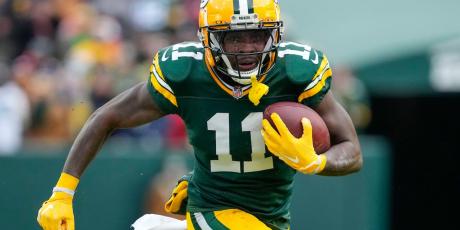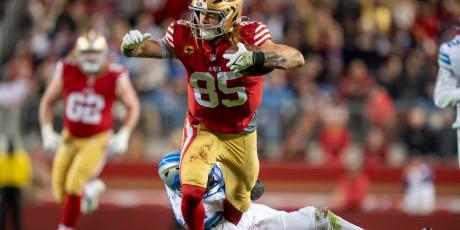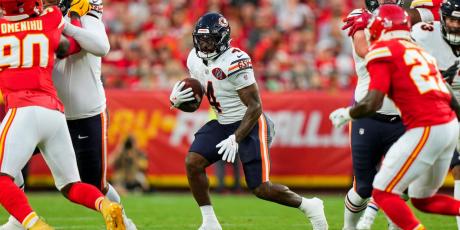Is Doug Martin Worth Stashing for 3 Weeks in Fantasy Football?

With Doug Martin suspended the first three games, it could be the Jacquizz Rodgers show in Tampa. Reports claim that Rodgers stands a chance at unseating suspended Martin for the starting job. Meanwhile, Charles Sims will also compete for touches.
Since we have no assurances Martin regains his role, Rodgers might be worth a look in the double-digit rounds. The situation mirrors Spencer Ware in 2016, when we knew he would have an extended role early with the chance for more. Neither Rodgers or Martin offers much in the passing game, but would-be beneficiary Sims will have rookie Jeremy McNichols to deal with. Sims' role, or at least his ceiling, could be held back by his coaching staff, unfortunately.
Can Rodgers hold on to the job when Martin returns from suspension? Will we see 2015 Martin? Or the 2016 Martin? What will the role of the talented but disappointing Sims be moving forward?
Rushing Expectation, which balances metrics with film evaluation—one of the toughest things to do in fantasy football—can provide clues as to how to attack the Buccaneers backfield in 2017 fantasy drafts.
Sign up with 4for4 to gain access to every single Rushing Expectation profile of 2017!
Rushing Expectation: Doug Martin
Martin is not exceedingly fast or dynamic in the open field, but his initial burst is good. He has above-average power and isn't afraid to get downhill to create holes through contact in a variety of directions:
Martin has rare pad level and runs through arm tackles frequently for additional yardage. He shows good mental processing in regards to knowing when to take necessary yardage through contact based on situation, and when to take a chances with simple cuts and changes of direction.
Martin’s above-average acceleration is most notable coming out of subtle moves behind the line of scrimmage. Once in the open field, he has average balance. Most of his chunk plays come through contact (even though he finished in just the 26th percentile in yards after contact).
Did Martin exceed or fall below expectation from an efficiency/metrics point of view?
The Buccaneers overall Expected Success Rate in on rushing attempts in 2016 was 42.8 percent, which is below the NFL average of 46.3 percent. The Bucs were better on targets to running backs, with a slightly above average Expected Success Rate of 45.4 percent.
Albeit in a micro-sample of just 15 rushes, Martin was most successful running towards the left tackle. Overall, he performed below expectation, with a 14th percentile Expectation Score among my 60-player sample.
Martin is solid as a receiver, but lacks the range of routes and versatility of Sims. Even when taking the Bucs' above-average pass-blocking into account, Martin performed below expectation in the receiving game with a 29th percentile Expectation Score.
Martin has below-average breakaway speed. His success is more reliant upon well-blocked plays than most backs that I've charted.
The most notable takeaway from Martin’s sample is that his efficiency was poor regardless of defensive situation: He finished in the 21st percentile against seven or less in the box, and in the 14th percentile against eight or more in the box (which he faced at a rate in the 89th percentile).
Rushing Expectation: Jacquizz Rodgers
Rodgers has above-average athletic ability. While perennially underrated, Rodgers does have some limitations as a running back.
In charting Rodgers, I see a runner who can hit a hole with solid burst and use his small frame to fit through tight creases.
Rodgers has very good finishing ability and balance through contact—the best in this backfield last season. Like Martin, Rodgers powers through arm tackles with ease. If given volume, Rodgers can grind his way a solid box score. He finished with a respectable 57th percentile Rushing Expectation score.
Rodgers has solid vision, but he's merely average at waiting for his blocks to develop. He leaves a lot of opportunities on the field. That said, he was still by far the most efficient back on the Bucs last season:
I will continue to stress that Expected Success Rate is an insanely useful metric because it does a great job separating a running back's performance from that of his blocking. Rodgers finished with an Expectation Score in the 54th percentile. But he also saw seven or less in the box a far higher rate than Martin or Sims.
Rodgers' sample in the receiving game falls just below my threshold to carry a relevant Expectation Score, but most of his targets were to the inside area of the field. Although Rodgers was very efficient on those targets, his receiving ability is adequate at best.
Overall, charting Rodgers has provided three noteworthy takeaways:
-
He was the only back on the Bucs to perform above expectation on the ground last season.
-
He was given significant volume.
-
He is not an elite talent and lacks versatility for his size.
Sometimes talent doesn’t matter. We have to defer to the history of the coaching staff at times like these. If Rodgers sees volume with Martin suspended like we expect, he’s clearly valuable in the first three weeks for that guaranteed workload alone.
Rushing Expectation: Charles Sims
Rodgers may have been the most efficient last year, but after charting Sims twice now, it's Sims that could easily be considered the most talented.
Sims has the size of a feature back. More impressively, he has elite mental processing skills, and his football intelligence is truly unique. He is not a flashy player by any means, but sees the field extremely well and recognizes penetration fast enough to help his quarterback consistently in the passing game if he senses danger.
Sims is thought of more as a sub-package, passing-down back, but has shown a relatively normal run distribution in back-to-back seasons.
Sims is a mature runner who does a good job pressing running lanes before he reaches the line of scrimmage. Although he has an upright running style, Sims is a competitive kid who understands how to get downhill in a hurry. Sims consistently makes plays through the various receiving avenues and types of routes, though he surprisingly saw zero targets in the flat again this season. He more frequently was targeted on passes to the inside and outside areas of the field. He also lined up as a wide receiver often.
Sims is not the kind of running back who is going to lose yards often—even in less than desirable situations where his line does not block well in front of him. He shows very good short-area burst and ability to accelerate. He is able to use his speed to get to the corner. One thing I noticed, however, is that he tends to bend runs rather than making violent, sharp cuts. Behind the line of scrimmage, Sims' cuts are small and precise,though he does have the athletic ability and agility to make defenders miss.
Sims was a tough case. His charting data in each of the past two seasons has been hardly comparable in regards to efficiency:
- 2015: Rushing Expectation Score in the 47th percentile
- 2016: Rushing Expectation Score in the 14th percentil
- 2015: Receiving Expectation Score in the 85th percentile
- 2016: Receiving Expectation Score in the 27th percentile
His yards before contact were also vastly different:
- 2015: Yards Before Contact in the 77th percentile
- 2016: Yards Before Contact in the 7th percentile
What gives?
Well ... I’m not completely sure, to be honest. It’s possible Sims couldn’t hold up as a feature back. Or maybe it had to do with injuries. Or both. The easy answer is that it probably falls somewhere in the middle, but that is probably also the most likely conclusion.
Sims' receiving skills are elite. He catches balls with his hands, shows the ability to catch with his back to the quarterback, and can consistently make plays downfield. Throw in his rare vision in the open field and his very good short-area burst, and his big-play ability should not come a surprise.
One constant in both seasons, however, is Sims’ putrid yards-after-contact average. He finished in the 12th percentile in 2015 and the 26th percentile in 2016 respectively. Though Sims has good power—in particular against corners at the second level—he showed marginal finishing ability to break through wraps and hits to his legs or below the knees. Sims' balance through contact is minimal, especially through arm contact, him being such a big back (6 feet, 214 pounds). Part of the problem is that Sims shows a lack of hip flexibility. Combine that with below-average pad level, and he runs into issues converting his speed into power.
Overall, charting Sims twice now has provided two noteworthy takeaways:
-
He is extremely versatile.
-
He has the potential to be much more than a change-of-pace back.
-
His step backwards in 2016 and Rodgers' effectiveness make him better suited for a fresh start on a new team.
Doug Martin: 2017 Fantasy Outlook
With how poorly Martin performed in all the metrics I value most in this process, it’s difficult to completely buy into all the preseason hype surrounding him. I’m simply not willing to draft a player who I don’t believe in around the No. 33 RB ADP range. I would much rather have Ameer Abdullah at No. 29 or Derrick Henry at No. 35 in that range, and then draft Rodgers late.
Jacquizz Rodgers: 2017 Fantasy Outlook
Rodgers is not a special talent, but he was by far the most efficient back on this team last year. He will see significant volume in Weeks 1-3 (with a real chance to keep the job).
That said, he has plenty of causes for concern, including:
-
Rodgers is average at waiting for his blocks to develop, which limits his big-play upside.
-
Rodgers’ receiving ability is adequate at best. He lacks the duel-threat ability you would want in a feature back.
Despite those concerns, and even though his ADP has climbed to the No. 51 RB, Rodgers is still a great value late in fantasy drafts—especially if Tampa Bay feels comfortable giving him the same level of insane volume he received last year.
Charles Sims: 2017 Fantasy Outlook
Maybe I can’t let it go. But I still love what I see from Sims on film. Nevertheless, he did not take advantage of his opportunity last year, for whatever reason. He should be involved in the receiving game, but is more of a flier than a league-winner. He could still exceed his No. 57 RB and maintain PPR appeal, but the rookie McNichols could also be given a complementary role. I’ll leave you with part of a conversation I had with TJ Hernandez because it perfectly sums up how I feel about Sims:
As much as I want Sims to happen, he may be best suited as a dynasty stash in 2017.
Note: Use our ADP tool to see the most up-to-date ADP on Martin, Rodgers, and Sims. And use our rankings (updated daily) and customizable cheat cheets to plan for your 2017 fantasy draft!
Related Articles
- Rushing Expectation 2017 List
- Will Joe Mixon Render Gio Bernard and/or Jeremy Hill Irrelevant?
- Can Paul Perkins Maintain a Stranglehold on the Starting Job?
- DeMarco Murray and Derrick Henry: Fantasy's Next Dominant Tandem?
- Is One Good Year Enough to Trust Melvin Gordon as a Fantasy Stud?
- Is Terrance West Actually Any Good?
- Jay Ajayi Has One of the Best Floor/Ceiling Combos in Fantasy
- Why Jordan Howard is Being Overvalued in Fantasy Football
- Marshawn Lynch's Handcuff: DeAndre Washington or Jalen Richard?
- Why You Should Avoid the Vikings' Backfield in Fantasy Football
- Spencer Ware's League-Winning Fantasy Upside is Being Ignored
- 7 Running Backs With an Easy Fantasy Strength of Schedule
- Bilal Powell is the Jets Back to Own Because Matt Forte is Trash Now
- Todd Gurley Isn't Worth Your Second-Round Fantasy Pick
- Ty Montgomery Has Massive Fantasy Upside
- Ameer Abdullah is the Lions Running Back to Own in Fantasy
- Does Isaiah Crowell or Duke Johnson Offer More Fantasy Value?
- Rushing Expectation 2017: An Introduction
- The Fantasy Value of Patriots Running Backs Mike Gillislee, James White, Dion Lewis & Rex Burkhead
- Stop Taking Adrian Peterson Over Mark Ingram in Fantasy
- Using Red Zone Expected Value to Find 5 Running Back Touchdown Regression Candidates
- What are the Most Predictable Year-to-Year Stats for Running Backs?
- 6 Reasons Jordan Howard Will Not Be a Fantasy Football Bust
- Leonard Fournette, Samaje Perine & the Other Rookies That Will Make a Fantasy Impact in 2017
- When Should You Draft Your Running Back?
- How Often Do Top-12 PPR Running Backs and Wide Receivers Repeat the Following Season?
- 2017 Initial Rankings: A Closer Look at Bilal Powell, Danny Woodhead and Theo Riddick
- What the Move to Philadelphia Means for LeGarrette Blount
- Danny Woodhead Had RB1 Upside at This Time Last Year - Does He Still?
- How Effective Will Marshawn Lynch Be in 2017?






















